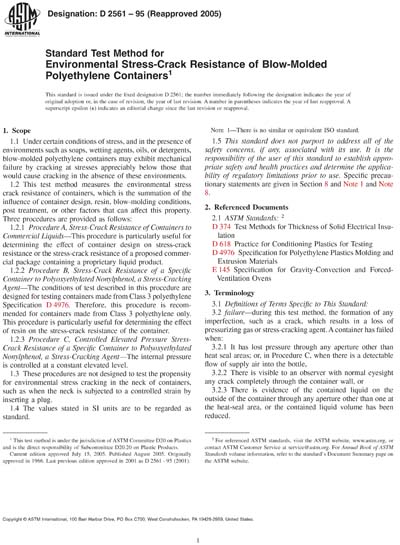Historical
ASTM D2561-95(2005)
Standard Test Method for Environmental Stress-Crack Resistance of Blow-Molded Polyethylene Containers
1.1 Under certain conditions of stress, and in the presence of environments such as soaps, wetting agents, oils, or detergents, blow-molded polyethylene containers may exhibit mechanical failure by cracking at stresses appreciably below those that would cause cracking in the absence of these environments.
1.2 This test method measures the environmental stress- crack resistance of containers, which is the summation of the influence of container design, resin, blow-molding conditions, post treatment, or other factors that can affect this property. Three procedures are provided as follows:
1.2.1 Procedure A, Stress-Crack Resistance of Containers to Commercial Liquids—This procedure is particularly useful for determining the effect of container design on stress-crack resistance or the stress-crack resistance of a proposed commercial package containing a proprietary liquid product.
1.2.2 Procedure B, Stress-Crack Resistance of a Specific Container to Polyoxyethylated Nonylphenol, a Stress-Cracking Agent—The conditions of test described in this procedure are designed for testing containers made from Type III polyethylene Specification D1248. Therefore, this procedure is recommended for containers made from Type III polyethylene only. This procedure is particularly useful for determining the effect of resin on the stress-crack resistance of the container.
1.2.3 Procedure C, Controlled Elevated Pressure Stress-Crack Resistance of a Specific Container to Polyoxyethylated Nonylphenol, a Stress-Cracking Agent—The internal pressure is controlled at a constant elevated level.
1.3 These procedures are not designed to test the propensity for environmental stress cracking in the neck of containers, such as when the neck is subjected to a controlled strain by inserting a plug.
1.4 The values stated in SI units are to be regarded as the standard.
Note 1—There is no similar or equivalent ISO standard.
1.5 This standard does not purport to address all of the safety concerns, if any, associated with its use. It is the responsibility of the user of this standard to establish appropriate safety and health practices and determine the applicability of regulatory limitations prior to use. Specific precautionary statements are given in Section 8 and Notes 1 and 9.
ASTM International [astm]

